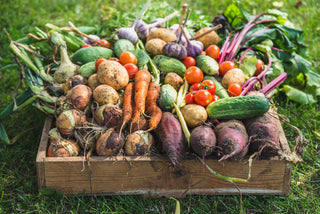Grafting citrus budwood is a great way to grow your own citrus trees, preserving the quality and traits of the parent plant. Whether you're working with mandarins or Japanese Satsuma mandarins, the success of your grafting process relies on following the right steps and selecting the appropriate rootstock. In this guide, we'll cover the entire process, from preparing rootstock to selecting the best grafting technique and ensuring aftercare success. We’ve also included a handy table to show which rootstocks are compatible with mandarins and Satsuma mandarins.
Step-by-Step Guide to Grafting Citrus Budwood
1. Preparation of Rootstock
Action: Choose a healthy, disease-resistant rootstock that is compatible with your citrus variety. The rootstock should be pencil-thick to support the new growth. Water the rootstock the day before grafting to hydrate it, and sanitise all your tools to avoid introducing disease.
Hidden Tip: Graft during the active growing season, from spring to early summer. This is when the bark will “slip,” making it easier to insert the bud. Avoid extreme weather conditions like frost or very high heat.
2. Selecting Budwood
Action: Select mature, disease-free budwood from a productive citrus tree, ideally from the current or previous season’s growth. Cut a 10–15 cm section containing at least 3-4 healthy buds. Keep the budwood fresh by wrapping it in a damp paper towel or cloth until you're ready to graft.
Hidden Tip: Always select plump, mature buds that aren’t too soft or dry. Healthy buds have a higher chance of successfully fusing with the rootstock and growing into a strong new tree.
3. T-Budding Process
Action:
- Make a T-Cut: On the rootstock, make a 2.5 cm vertical cut, followed by a horizontal cut across the top to form a T-shape. Gently peel back the bark to expose the cambium layer beneath.
- Prepare the Bud: Cut a healthy bud from the budwood, making sure to take a thin slice of bark and cambium.
- Insert the Bud: Carefully slip the bud under the bark of the rootstock, ensuring that the cambium layers of both the bud and rootstock align as closely as possible.
- Secure the Bud: Wrap the area with budding tape, ensuring the bud itself is exposed but the rest of the graft is secure.
Hidden Tip: The cambium layers (the green tissue beneath the bark) of both the bud and the rootstock must align correctly for the graft to succeed. Avoid covering the bud with tape, as it needs exposure to grow.
4. Aftercare
Action: Water the rootstock regularly, but avoid overwatering. Check the graft after 2-3 weeks to ensure the bud is still green and healthy. Once the graft has taken and fused with the rootstock (usually 3-4 weeks), carefully remove the budding tape.
Hidden Tip: Protect the young graft from environmental stressors such as wind and harsh sunlight. Use a shade cloth or temporary windbreak to help the graft heal and encourage growth.
5. Encouraging Bud Growth
Action: After the graft has taken, cut off the rootstock just above the graft site to promote growth from the new bud. Remove any shoots or suckers growing below the graft to ensure the plant’s energy is directed towards the new growth.
Hidden Tip: If your tree is in a pot, rotate it regularly to ensure even sunlight exposure, which promotes balanced growth. Consistent care at this stage is critical to developing a healthy tree.
6. Fertilising and Protection
Action: Apply a balanced, slow-release fertiliser designed for citrus trees. This will give your grafted tree the nutrients it needs for steady growth. Keep an eye out for common citrus pests like aphids or scale, which can hinder growth.
Hidden Tip: Deep watering is essential for citrus trees, but make sure the soil has a chance to dry slightly between watering to avoid root rot. Monitoring moisture levels and checking for pests early can prevent larger issues down the road.
Rootstocks Compatible with Mandarins and Japanese Satsuma
Choosing the right rootstock is crucial for the success of your grafted citrus tree. Different rootstocks affect tree size, growth rate, fruit quality, and resistance to diseases. Here’s a table that outlines which rootstocks are most compatible with mandarin and Japanese Satsuma trees, as well as their key characteristics.
| Rootstock | Compatibility | Suitable for Mandarins (Citrus reticulata) | Suitable for Japanese Satsuma (Citrus unshiu) | Key Characteristics |
|---|---|---|---|---|
| Flying Dragon (Poncirus trifoliata var. 'Flying Dragon') | High Compatibility | Yes | Yes | Dwarfing rootstock, cold-hardy, slow growth, improves fruit quality. |
| Troyer Citrange (Poncirus trifoliata × Citrus sinensis) | Moderate Compatibility | Yes | Yes | Cold-hardy, drought-tolerant, suitable for various soil types. |
| Carrizo Citrange (Poncirus trifoliata × Citrus sinensis) | Moderate Compatibility | Yes | Yes | Vigorous, drought-resistant, similar to Troyer but more vigorous. |
| Cleo (Citrus reshni) | Moderate Compatibility | Yes | Yes | Vigorous growth, salt-tolerant, good for deep sandy soils. |
| Swingle Citrumelo (Poncirus trifoliata × Citrus paradisi) | High Compatibility | Yes | Yes | Highly disease-resistant, cold-tolerant, adaptable to many soils. |
| Rough Lemon (Citrus jambhiri) | Moderate Compatibility | Yes | Yes | Highly vigorous, tolerates poor soils, but sensitive to cold. |
| Volkamer Lemon (Citrus volkameriana) | Moderate Compatibility | Yes | Yes | Vigorous rootstock, suitable for high pH soils, but sensitive to cold. |
| C-35 Citrange (Poncirus trifoliata × Citrus sinensis) | High Compatibility | Yes | Yes | Semi-dwarfing, cold-tolerant, high fruit quality. |
| Sour Orange (Citrus aurantium) | Moderate Compatibility | Yes | Yes | Good for clay and loam soils, disease-resistant, sensitive to tristeza virus. |
| Sun Chu Sha (Citrus reticulata) | High Compatibility | Yes | Yes | Dwarfing, suited for sandy soils, high fruit quality. |
Key Takeaways
- Rootstock Choice: Your choice of rootstock can determine the size, growth speed, and disease resistance of your citrus tree. Pick one suited to your local climate and soil conditions.
- Proper Timing: Grafting during the growing season (spring or early summer) ensures the best success, as the tree’s bark slips more easily and facilitates proper fusion.
- Caring for the Graft: Watering, fertilising, and protecting the graft are crucial to helping your new tree grow. Rotate the plant for even sunlight and remove any competing growth below the graft site.
With this guide and careful attention to detail, you can successfully graft citrus budwood to grow healthy and productive mandarin or Japanese Satsuma trees. For more tips and to shop our range of citrus trees, seedlings, and rootstocks, visit www.qpseedlings.com.au.




